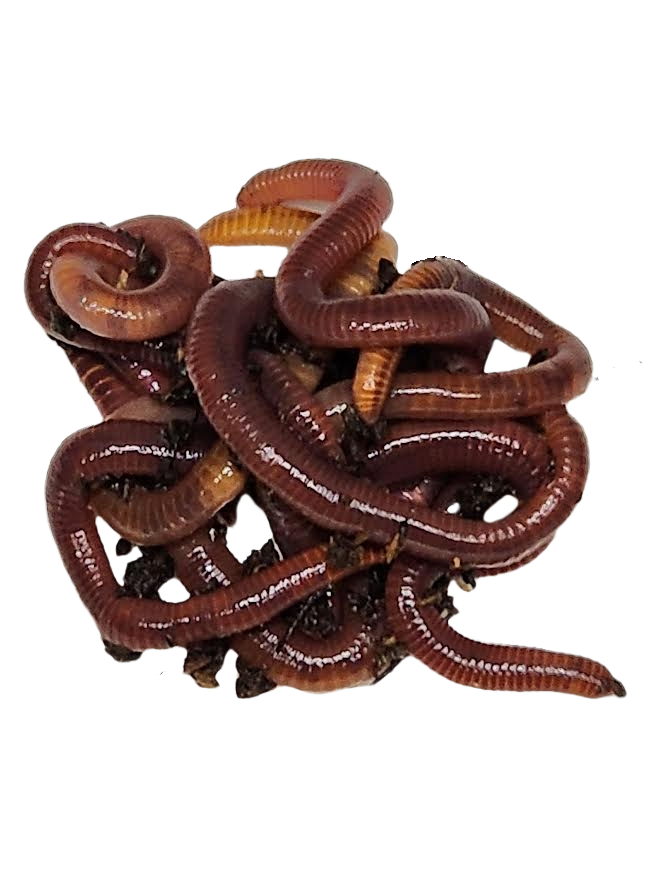Where to Buy Worms in North Carolina for Gardening and Composting Needs
The Ultimate Overview to Caring for Red Wigglers in Your Garden
Caring for red wigglers in your yard is a necessary element of lasting composting practices that can substantially improve dirt health and wellness and fertility. Comprehending their particular environment demands, nutritional choices, and maintenance needs is vital for fostering an efficient vermicomposting environment.
Recognizing Red Wigglers

Red wigglers are characterized by their reddish-brown pigmentation and fractional bodies, which can grow up to 4 inches in size. They possess a high reproductive price, generating cocoons that include numerous embryos, considerably enhancing their population in ideal environments. Where to buy red wigglers. Their physiology permits them to endure numerous wetness levels, although they flourish in damp problems, ideally in between 60 ° F and 80 ° F.))

Establishing the Habitat
Producing an optimal environment for red wigglers is crucial for optimizing their composting efficiency and overall health. Red wigglers thrive in a damp, dark setting with a temperature level range of 55 to 77 degrees Fahrenheit.
When picking a container, select one that is well-ventilated to enable air blood circulation while avoiding excess moisture loss. Plastic bins, wood boxes, or specialized worm bins are all reliable alternatives. The base of the container should have water drainage holes to stop water build-up, which could bring about anaerobic conditions hazardous to the worms.
For bed linen, use shredded newspaper, cardboard, or coconut coir, guaranteeing it is not soaked but wet. This bed linens serves not just as a habitat however additionally as a resource of carbon. Routinely inspect the dampness degree of the bed linen, and include water as needed to preserve the excellent wetness. By developing these problems, you will produce a growing environment for your red wigglers, urging reliable composting and much healthier worm populations.
Picking the Right Food
Selecting the proper food for red wigglers is crucial for their health and wellness and composting efficiency. These worms thrive on a balanced diet regimen that includes a variety of natural products. Suitable food sources include vegetables and fruit scraps, coffee grounds, crushed eggshells, and shredded paper. It is important to stay clear of meats, milk products, and oily foods, as these can attract pests and create undesirable odors in the composting atmosphere.
Red wigglers favor food that is cut or shredded, as this increases surface area and advertises much more effective digestion. In addition, presenting food in tiny amounts avoids overfeeding, which can bring about anaerobic problems harmful to worm wellness. Keeping an eye on the worms' eating routines can also offer insights; if the food is eaten promptly, take into consideration progressively boosting the quantity.

Maintaining Wetness and Temperature Level
A well balanced diet is only component of the formula when it involves ensuring the health and article source wellness of red wigglers; keeping proper moisture and temperature level is equally vital. Red wigglers prosper in a damp setting, preferably between 70-85 ° F(21-29 ° C) This range supports their metabolic processes and boosts their capacity to break down raw material efficiently.
Alternatively, too much moisture can develop anaerobic problems, which may damage the worms and generate undesirable odors. On a regular basis inspecting the wetness material and adjusting as necessary is important for a thriving worm population.
To alleviate temperature extremes, consider making use of insulation for outside bins or relocating the bin to a shaded or temperature-controlled location. By very carefully handling both dampness and temperature, you create an optimum setting for red wigglers, enhancing their efficiency and total health.
Harvesting Compost and Treatment Tips
Harvesting compost from your red wigglers is a satisfying procedure that not only advantages your yard but likewise improves the performance of your worm bin - Where to buy red wigglers. To begin, select a harvesting approach that matches your arrangement-- whether it's the tray, pyramid, or standard bin approach. Each technique permits the splitting up of garden compost from worms effectively
When you prepare to harvest, concentrate on timing. Preferably, wait up until the compost is dark, brittle, and earthy-smelling, commonly after 3 to 6 months of digestion. To collect, you can delicately dig deep into the compost from one side of the bin, allowing worms to move to the uninterrupted side. Additionally, you can use light to wikipedia reference motivate worms to tunnel much deeper, making it much easier to accumulate the completed garden compost.
Treatment suggestions after harvesting consist of renewing your worm bin with fresh bedding and food scraps to keep a healthy and balanced worm populace. Ensure that the dampness and temperature level degrees stay ideal, and frequently check for any signs of distress among the worms. By following these techniques, you'll guarantee a lasting cycle of garden compost manufacturing that enriches your yard.
Conclusion
In conclusion, the effective treatment of red wigglers requires a thorough understanding of their environment, dietary demands, and ecological problems. Establishing a suitable environment with proper ventilation and wetness degrees is important for cultivating their health and productivity.
By developing these conditions, you will create a thriving setting for your red wigglers, motivating efficient composting and healthier worm populations.
The pH degree of the food is another important variable; red wigglers grow in a somewhat acidic to neutral setting.A well balanced diet is only part of the formula when it comes to ensuring the health and wellness of red wigglers; maintaining correct wetness and temperature is similarly important. By carefully managing both moisture and temperature level, you develop an ideal atmosphere for red wigglers, enhancing their performance and overall health and wellness.
Collecting garden compost from your red wigglers is a rewarding process that not only advantages your garden yet also improves the efficiency of your worm container.